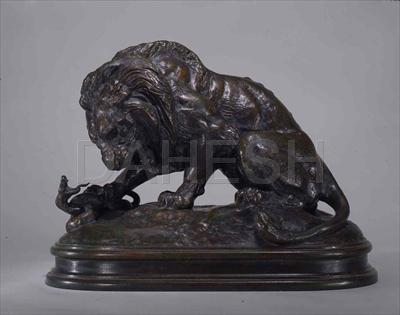Antoine-Louis Barye (French, 1796–1875)
Lion and Serpent, modeled 1833
Bronze, 10 1/4 x 7 1/8 x 13 7/8 in.
Signed on base right edge by tip of the tail: BARYE
1995.14

The best of Barye’s sculptures surpass mere anatomical description and resonate with human passion and conflict. Lion and Serpent (plaster model, Musée des Beaux-Arts, Lyon), Barye’s most famous work, has also been read as an allegorical representation of King Louis-Philippe’s (reigned 1830–1848) rise to power during the July Revolution of 1830. The noble lion, representing the new King and the people of France, is shown in a triumphant struggle against the serpent, symbolizing Charles X (reigned 1824–1830) and the ousted Bourbon dynasty. The pair additionally suggests a celestial sanction for Louis-Philippe’s reign by alluding to the constellations of Leo (the lion) and Hydra (the sea serpent), which “ruled the heavens” during the days of the July Revolution (July 27-30, 1830). Barye exhibited his monumental plaster cast of this allegorical group at the Salon of 1833, where it was met with great acclaim. It was purchased by the Crown, cast in bronze, and exhibited again at the Salon of 1836, before being publically installed in the Tuileries garden. Although officially sanctioned by Louis-Philippe, the presence of a large-scale animal sculpture in such a public venue exasperated at least one critic in particular, who exclaimed, “Are the gardens to become a Menagerie?”
Barye created several variations of his Lion and Serpent and offered smaller copies for purchase through his catalog in at least two sizes—the bronze in the Dahesh collection is one of the slightly larger reductions, with a height around 10 inches.


